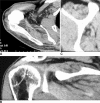Natural history of fatty infiltration and atrophy of the supraspinatus muscle in rotator cuff tears
- PMID: 20094853
- PMCID: PMC2865597
- DOI: 10.1007/s11999-009-1207-x
Natural history of fatty infiltration and atrophy of the supraspinatus muscle in rotator cuff tears
Abstract
Background: In some patients nonoperative treatment of a rotator cuff tear is sufficient, while in others it is only the first stage of treatment prior to surgery. Fatty infiltration progresses throughout the nonoperative treatment although it is not known at what point fatty infiltration contributes to poor functional outcomes, absence of healing, or increased rerupture rates.
Questions/purposes: We therefore identified factors related to the appearance of supraspinatus muscle fatty infiltration, determined the speed of appearance and progression of this phenomenon, and correlated fatty infiltration with muscular atrophy.
Methods: We retrospectively reviewed 1688 patients with rotator cuff tears and recorded the following: number of tendons torn, etiology of the tear, time between onset of shoulder symptoms and diagnosis of rotator cuff tear. Fatty infiltration of the supraspinatus was graded using either CT or MRI classification. Muscular atrophy was measured indirectly using the tangent sign.
Results: Moderate supraspinatus fatty infiltration appeared an average of 3 years after onset of symptoms and severe fatty infiltration at an average of 5 years after the onset of symptoms. A positive tangent sign appeared at an average of 4.5 years after the onset of symptoms.
Conclusions: Our results suggest that rotator cuff repair should be performed before the appearance of fatty infiltration (Stage 2) and atrophy (positive tangent sign)-especially when the tear involves multiple tendons.
Level of evidence: Level IV, prognostic study. See Guidelines for Authors for a complete description of levels of evidence.
Figures



References
-
- Bernageau J, Goutallier D, Postel JM. Density study of the muscles of the rotator cuff [in French]. In: Laredo JD, Bard H eds. Monographies du GETROA. Montpellier, France: Sauramps Medical; 1993:277–281.
-
- Bigliani LU, Cordasco FA, McIlveen SJ, Musso ES. Operative treatment of failed repairs of the rotator cuff. J Bone Joint Surg Am. 1992;74:1505–1515. - PubMed
MeSH terms
LinkOut - more resources
Full Text Sources
Medical
Research Materials

